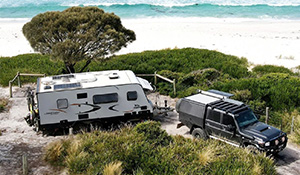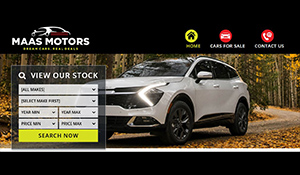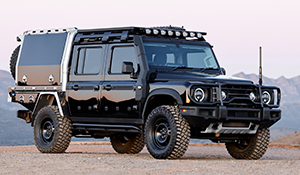Vehicle Test - 2017 Volkswagen Amarok V6 Highline Review
WHEN THE VOLKSWAGEN AMAROK arrived on the market almost seven years ago, the wags were cruel with many a motoring story or Facebook post deriding the thing’s 2.0-litre four-cylinder turbo-diesel engine… ‘Only milk and juice comes in two litres’ they would say.
Well, they can’t say that anymore. See, late last year, Volkswagen updated its Amarok with the release of a V6 turbo-diesel-toting model which also received an updated interior and a tweaked snout. The four-cylinder variants received these updates earlier this year.
The new engine was the Headline-grabber for the Amarok and it set about redressing the power deficiency the Amarok suffered against key rivals. The 3.0-litre V6 turbo-diesel is the same engine that’s seen service in both the Porsche Cayenne and Audi Q7, and makes 165kW and 550Nm of torque from less than 1500rpm, it is mated to an eight-speed automatic and drinks a combined 7.8L/100km.
The Amarok V6 is only available in top-spec Highline and Ultimate model grades, and is priced from $59,990+ORC and $67,990+ORC, respectively. Even at that price, there are still extra cost options, including Pearl Effect paint ($590); Leather Upholstery which includes heated front seats ($2690); Alcantara upholstery ($1890) – fitted to our test car; and 20-inch Talca alloys ($990 for five).
Beyond the engine, the changes include new front seats, new infotainment system and multi-collision braking system, as well as a revised front-end design.

What’s the interior like?
Measuring 5.25 metres long and 2.23 metres wide (including the wing mirrors), the Amarok isn’t a small vehicle which means there’s plenty of room inside and a decent-sized tray to boot. In all, the interior has a typical VW design (read, practical and functional), and the choice of materials mirrors that of other VW commercial vehicles, like the Transporter, meaning the plastics are harder than those in the passenger cars, but the grain of the plastic gives them a soft instead of scratchy feel to the touch.
The Amarok, however, adds design touches to lift the feel of cabin beyond workhorse to show pony, with brushed alloy accents around the air-con vents, the ‘lacquer bar’ that stretches from one side of the car to the other (adding to the sense of quality and cabin width) and the cost-optional Alcantara seats in our test car.
Climbing into and out of the Amarok isn’t an issue, the doors swing out nice and wide (only an issue if you’re parked in a tight underground car park and then you might have to squeeze yourself out) and there’s an A- and B-Pillar grab handle to help those in the front and back climb in. In my week with the Amarok, I used it to ferry my kids around on the school run and the only issue I had was with my five-year old not being able to reach the grab handle and needing a bit of help to scramble up into the thing. The older child didn’t have a problem.
When I initially swung into the front, the new, ‘ergonomic’ front seats felt flat and unsupportive but that feeling faded away after five minutes in the thing. My run back to the office after collecting the Amarok was a click or two over 100 kilometres and I arrived feeling fresh and kink free; I’d go as far to say these are easily the best seats on any of the dual-cab utes on the market today, and that they’ve been praised by Germany’s Healthy Back Campaign isn’t surprising.

There’s plenty of adjustment on the seats and the steering wheel and so getting comfortable behind the wheel, whether you’re tall or short, won’t be a problem. From the driver’s seat, all the controls are neatly laid out, with the infotainment pushed up nice and high so that you only have to glance across to see it, rather than down and across as you do in some of this car’s competitors; Toyota HiLux, I’m looking at you. Vision right around is excellent for such a big vehicle, and the reversing camera offers dynamic guide lines and a good field of view.
Climb into the back and there ISOFIX mounts on the two out-board seats and plenty of room for three adults across the back. I travelled in the back with my kids on one drive and, even with my daughter’s booster seat, there was still ample room.
The base of the back seat can be folded up (they’re split 60:40) against the backrest, or you can fold down the back rest onto the seat base, making the rear seat area of the Amarok a very practical and flexible space. There’s are two cup holders that fold down below the middle seat in the back and there’s a 12V outlet at the back of the centre console for backseat passengers to use. The door-mounted bins will hold a 1.5L bottle in the front and a 1L bottle in the back.
Probably my only gripe with the interior of the Amarok is the centre console storage bin or, not so much the bin which is a useful size, but the height of it. It’s mounted too low to be a useful armrest; first-world problems, eh.

What’s the infotainment like?
The infotainment unit is one of the key upgrades in the more-power Amarok, and now across the rest of the range. The full-colour display features capacitive touch, and can be both swiped and pinced to zoom, just like your smartphone.
The menu is laid out horizontally, allowing you to swipe through it and while it’s perhaps a touch too sensitive on initial use, familiarity means you’ll be able to adjust your touch, even while driving, and not select something you didn’t want. Thankfully, however, there are menu shortcut buttons to the side of the screen which allow you to deep dive straight into, either the phone, radio, or back to the main menu, etc. I’m not a fan of car makers that remove these shortcut buttons in the name of decluttering the dashboard. Moving on.

There are six speakers in all, four in the front and two in the back, and the sound quality is excellent. But that’s not the best bit, nope, there’s an odd-looking little button (two people and a microphone) on the unit that allows you to amplify your voice via the rear speakers so that you no longer have to turn around to be heard in the back of the Amarok… that’s not necessarily a problem in this thing as it’s so quiet, much quieter than all of its key competitors across all surfaces, but it is a cool function if you’ve got kids and you, well, need to get your point across… Touching the button again deactivates the function.
The Amarok’s infotainment system also features App Connect, which is VW’s way of saying it offers Mirror Link, Apple CarPlay and Android Auto and the system, Apple CarPlay anyway, works flawlessly. There’s a small cubby at the base of the centre stack where you can stash your phone and more (it’s a big space) and there’s a USB port and AUX IN interface at the back of it. Digital Radio is standard with the system.

What’s the load space like?
The Amarok’s tray, in double-cab configuration, measures 1.55 metres long and 1.62 metres wide and it is half-a-metre deep. Drop the tail-gate, which is heavy, be warned, and the load height from the ground is only 78 centimetres which makes loading and unloading to the ground a little less back-breaking. There’s a 12V outlet in the tub and a rear-mounted LED light for illuminating the tub at night.
There are four strong metal tie-downs in each corner of the tub and two extra can be added cost-optionally. While testing the Amarok, I used them to lash down half-a-dozen hardwood sleepers and there wasn’t a skerrick of flex. The maximum payload is 900kg.
The factory-fitted plastic tub liner has always been an Achilies heel for the Amarok, in my opinion. I remember when the Amarok was first launched in this country out in the Flinders Ranges and driving across corrugated dirt roads saw the thing jiggling and rattling. And, unfortunately that hasn’t changed. A drive across some beautifully graded dirt roads last weekend saw the tub liner squeaking with every little bump. Fortunately, you don’t notice it on the black-top.

What’s the Amarok V6 like to drive?
The Amarok runs a 3.0-litre V6 turbo-diesel that’s also seen service in the Porsche Cayenne and Audi Q7. The engine makes 165kW from 2500-4500rpm and 550Nm of torque from 1500-2500rpm, it’s mated to an eight-speed automatic transmission and runs VW’s 4Motion all-wheel drive system. The drive split in normal driving conditions is 40:60 front to rear.
Interestingly, the Amarok doesn’t have low-range, instead relying on its permanent all-wheel drive system via a Torsen centre differential and a rear differential lock. But that doesn’t make it any less capable off-road than its competitors, in fact, in some situations it’s superior to them. Back to the engine.
On the road, the Amarok never, ever feels stressed with a simple flex of your big toe all that’s needed for overtaking. The eight-speed automatic is excellent and does a good job of keeping the power pouring on nice and smoothly. Indeed, none of the Amarok V6’s competitors feel quite as smooth at around town speeds and higher.

Off-road and on lower-speed dirt roads, the Amarok V6 offers the same delicate throttle control its smaller-engined sibling is known for. Where it becomes a little (and I emphasise little) clumsy feeling is when you’re trying to hold, say, 40km/h in varying terrain and the transmission tries to plump for a higher gear for better fuel consumption, but then has to drop back a couple of gears as you hit a hill. To be fair, though, it’s only noticeable because in general driving the transmission is buttery smooth.
Fuel consumption was good, too, and across more than 400 kilometres of mixed driving I used just 7.5L/100km, which is better than the claimed combined 7.8L/100km.
In all, this is an incredibly strong and smooth engine that, combined with the comfortable seats, would make conquering long distances a cinch.
Our Robert Pepper has extensively tested the Amarok off-road and you can read his appraisal online at Practicalmotoring.com.au but, in a nutshell, the thing works very well. As mentioned, its low-speed throttle control is better than some vehicles with low-range and the traction control is quick and effective, although it’s disabled on the front if you activate the rear differential lock… in his testing of the Amarok, our Robert suggested in most off-road driving situations he’d prefer to use the Amarok’s traction control rather than the rear differential lock, because of its fine-tuned calibration and effectiveness.

The Torsen centre differential can’t be locked unlike Toyota 4x4s which also use a Torsen centre differential that can be locked; this means in some situations the Amarok just needs to work a bit harder. The hill descent control is excellent and the fact pressing the Off-Road button tweaks the ABS is a good and useful feature; it allows the wheels to brake, turn, brake, turn, etc to build up a wedge of dirt in front of them to aid in stopping on dirt roads.
The Amarok V6 offers a 29-degree approach angle, 24-degree departure angle and a 23-degree ramp-over. Ground clearance is 192mm with more than 200mm of clearance the norm in this segment.
As good as the Amarok is when the going gets rough, it’s the way it drives on the road that puts it ahead of its competitors. It feels ‘car-like’ is, honestly, the best way of describing it to someone who’s never driven one.
On the highway, you really could be forgiven for thinking you’re driving a big station wagon. The steering, throttle response, gearbox and brakes all feel well weighted and easy to control. The brakes are nice and progressive with good feel through the pedal, too. At around town speeds, the only thing that gets in the way of an otherwise excellent vehicle is the steering, the lower the speed the less connected it tends to feel with a touch of slackness in the straight-ahead position.
What about the ride? Well, it’s one of the best, if not the best, in this segment. The body control front to back and in general cornering, loaded or not is excellent and thanks to 4Motion permanent all-wheel drive you don’t ever get a feeling of thing wanting to oversteer; indeed, the slight rear bias of the torque split means the Amarok V6 is probably the sharpest-handling dual-cab on the market.

As mentioned, the front-to-back and general body control when cornering is excellent with all but the worst of the roads bumps and ruts heard rather than felt. But the Amarok V6 struggles a bit in the way it handles side-to-side movement (but that’s only because it comes standard with heavy-duty springs – a double-edged sword, if you like); indeed, while testing it on a rutted dirt road my passenger reached for the grab handle so badly was the thing rocking from side to side and that was at 40km/h… My gut tells me that with ‘comfort’ springs the vehicle wouldn’t have reacted in the same way.
In the end, though, the most difficult thing about judging the Amarok’s ride and handling is that you mentally start comparing it to wagons and high-riding station wagons rather than against some of its more agricultural competitors. And that says a lot about the Amarok V6 and just how far ahead of the pack it is in so many ways.

What are its safety features like?
The original Amarok 4x4 variant realised a five-star ANCAP rating when it was launched in 2011. Amarok gets driver and front passenger airbags as well as side and thorax airbags (but these don’t extend into the back). It offers 4Motion permanent all-wheel drive, a reversing camera and parking sensors, multi-collision braking which sees the system apply the brakes in the event of a collision to reduce the severity of a secondary impact. There are tyre pressure sensors, trailer stability recognition which tweaks the system when instability caused by a trailer is detected. It also offers hill-hold assist and more.
What do we think?
At $59,990+ORC, the Amarok V6 Highline isn’t fishing for fleet buyers, it’s aiming at those who want a vehicle that can serve as a family vehicle first and a work vehicle second. It’s not cheap, but it’s list price makes it slightly cheaper than the Ranger Wildtrack although that car gets leather as standard and the Amarok doesn’t, and it’s a lot more expensive than the HiLux SR5 (which lists from $55,990+ORC).
But, the Amarok V6 is better to drive than both of those cars and, even if the Ranger and HiLux have a slight edge off-road (and we will try and do a three-way comparison soon), the Amarok V6 is a much better on-road vehicle and by a long way too. More than that, the Amarok V6 has a nicer interior than its competitors and one that feels like it last long after the others have rattled to bits. The infotainment system leaves that fitted to the Toyota HiLux and Nissan Navara for dead and is easier to use and looks better, but offers a little less functionality than Ford’s Sync3 system.
If you’re looking for a vehicle that’s good off-road, excellent on-road, looks good, gets a good amount of kit as standard, and will easily accommodate five adults then the Amarok V6 should be at the top of your list.

2017 Volkswagen Amarok V6 Highline
Price From $59,990+ORC
Warranty three-years, unlimited kilometres (can be extended to five years)
Safety five-star ANCAP
Engine 3.0-litre V6 turbo-diesel
Power 165kW from 2500-4500rpm
Torque 550Nm from 1500-2500rpm
Transmission eight-speed automatic
Drive 4Motion permanent all-wheel drive
Dimensions 5254mm (L); 2228mm (W- including mirrors); 1878mm (H); 3095 (Wheelbase)
Angles 28.0 (A); 23.6 (D); 23.0 (R)
Ground Clearance 192mm
Turning Circle 12.95m
Weight 2169kg
Payload 911kg
GVM 3080kg
GCM 6000kg
Towing 3000kg
Towball 300kg
Spare full-size underslung
Fuel Tank 80 litres
Thirst 7.8L/100km (combined)
























